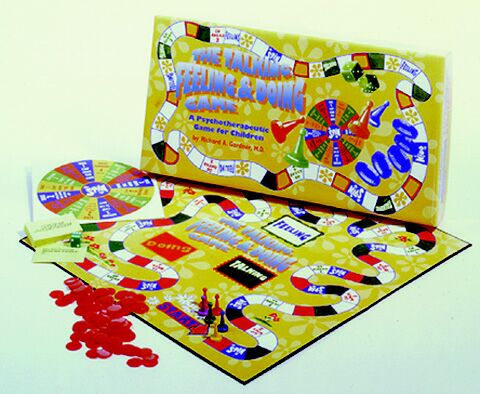 by Dr. Richard A. Gardner
by Dr. Richard A. Gardner
This game was developed to enable therapists to learn more about their child patient's psychological processes. Children in treatment do not generally come forth with revelations about themselves, especially those that may cause psychological pain, anxiety, shame, or guilt. This game enables children to provide such information in a way that is nonthreatening.
Full Description:
The Talking, Feeling, and Doing Game - devised by Dr. Richard A. Gardner in 1968 and first published in 1973 - has enjoyed worldwide utilization as an extremely effective psychotherapeutic instrument. Most child therapist's consider it an indispensable part of their playroom equipment. With a high degree of predictability, the game will engage the most resistant and inhibited children into meaningful psychotherapeutic endeavors. The game routinely facilitates disclosures often not otherwise obtainable. Further, the material elicited by the game serve as points of departure for meaningful psychotherapeutic interchanges. The Talking, Feeling, and Doing Game - A Psychotherapeutic Game for Children was developed to enable therapists to learn more about their child patient's psychological processes. Children in treatment do not generally come forth with revelations about themselves, especially those that may cause psychological pain, anxiety, shame, or guilt. This game enables children to provide such information in a way that is nonthreatening. In short, it enables the therapist to find out what is going on in the child's mind in the context of a friendly and often enjoyable game format - so universally appealing to children. It utilizes the vehicle of standard board game play, a format with which most children are familiar. The game has proved helpful for shortening the psychotherapeutic process because quickly and predictably provides the therapist with information about the child's underlying psychological processes. Information that might have taken weeks or even months to elicit may even be obtained during the first few sessions. The game was originally designed to enable inhibited children to reveal themselves, but even children who are more freely engaged in direct discussion and insight-oriented therapy will find it a pleasurable additional psychotherapeutic experience. Sales of the game are restricted to qualified mental health professionals. Buyers must hold at least a Masters Degree in psychology, counseling, social work or a related field, and should have received appropriate clinical training in working with children or adolescents. Please include license number or the name of your graduate school, degree, and year graduated as part of the order. The game is not sold to parents. Parents please see The Helping, Sharing, and Caring Game. Also available: New card decks to be used with the board game. Sold seperately.
Each card game contains 99 cards and follows the format of the original board game, focusing on specific problem or concerns of children. Like the original game, the card game is sure to help children communicate their feelings and develop insight into their problems. No duplicate questions because card decks and original game card.
Talking, Feeling & Doing Teasing Card Game Talking, Feeling & Doing Good Behavior Card Game Talking, Feeling & Doing Anger Card Game Talking, Feeling & Doing Shyness Card Game Talking, Feeling & Doing Divorce Card Game Also available:
The Talking, Feeling, & Doing Workbook
The Psychotherapeutic Use of the Talking, Feeling, & Doing Game and Other Projective Techniques Also Available
Talking Feeling Doing Game and 5 Decks of Cards Set
Game board, 108 Talking Card, 108 Feeling Cards, 108 Doing Cards, spinner, 6 pawns, bag of chips, 2 dice
ISBN:
Stock: Usually ships in 3-5 business days!
|